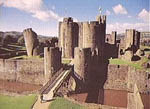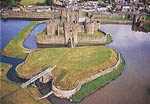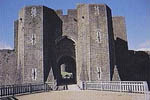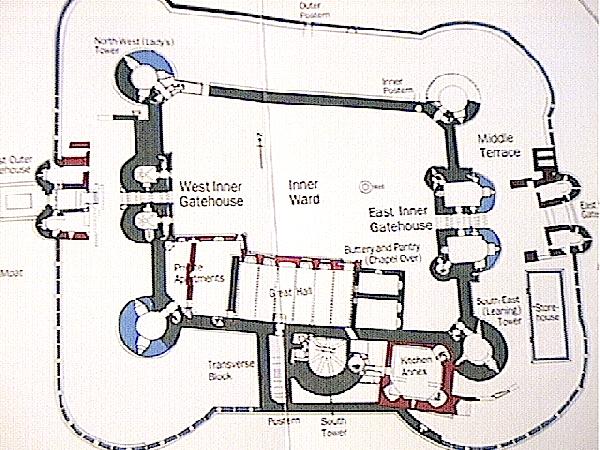Caerphilly Castle
By Lord Cynwrig ap Meurig (mka
Cody Sibley)
Caerphilly Castle which is located in the
town center of Caerphilly, South Wales is one of the most well known castles in
all of Wales. It's enormous size combined with the complexity of its land and
water defenses draw much interest from both history mavens and castle buffs. It
spans about 30 acres and is a prime example o the might of medieval military
architecture.
The site's strategic qualities were first
recognized by the Romans during their military conquest of southeast Wales. In
75 AD, the Romans built a fort for about 500 auxiliary soldiers in Caerphilly,
but abandoned it 50 years later. During the Norman invasion in the 11th
century, the site was left to the Welsh. The conquerors were more focused on the
fertile coastal plains and left the mountainous uplands alone. For nearly 200
years, Caerphilly Mountain served as a geographical barrier between the Welsh
and the Anglo-Normans.
 However, in the 1260's, the minor native lords of upland Glamorgan found
themselves caught in the web of national politics. The ambitious last Welsh
Prince of Wales, Llywelyn ap Gruffudd, was in control of Breconshire to the
north and was poised to move further south. But Gilbert de Clare, the powerful
Marcher lord, was determined to avoid such a catastrophe and rapidly moved north
in 1267 where he captured the native ruler of the Caerphilly site, Gruffudd ap
Rhys. The following year, he began construction of Caerphilly itself.
However, in the 1260's, the minor native lords of upland Glamorgan found
themselves caught in the web of national politics. The ambitious last Welsh
Prince of Wales, Llywelyn ap Gruffudd, was in control of Breconshire to the
north and was poised to move further south. But Gilbert de Clare, the powerful
Marcher lord, was determined to avoid such a catastrophe and rapidly moved north
in 1267 where he captured the native ruler of the Caerphilly site, Gruffudd ap
Rhys. The following year, he began construction of Caerphilly itself.
In 1270, Llwelyn attacked and burned the
castle shortly after construction of it's formidable defenses had begun. This
created such a stirring that a full scale war was only avoided through skillful
negotiation and the intervention of King Henry III. Llwelyn withdrew from
Caerphilly and it was re-occupied by de Clare in 1271 at which time construction
was resumed. In 1291, de Clare died; and construction of Caerphilly was
continued by his son, another Gilbert.
 Caerphilly was built in a concentric design with successive defense lines set
one inside the other. If an attacker forced his way through the first line of
defense, he would find himself faced with a second. This defense system was
fully utilized later in Edward I's great castles in North Wales.
Caerphilly was built in a concentric design with successive defense lines set
one inside the other. If an attacker forced his way through the first line of
defense, he would find himself faced with a second. This defense system was
fully utilized later in Edward I's great castles in North Wales.
The first line of defense against any
attack was the outer moat, spanned by two drawbridges, and backed by a huge
curtain wall and gatehouse. The lakes which surround Caerphilly made it almost
impossible to utilize the standard methods of siege warfare. Stone hurling
catapults could not be brought within range; siege ladders were useless from
such a great distance; and tunnelling under the water to undermine the walls was
completely impractical.
The second line of defense was the inner
moat and gatehouses of the outer ward. These defenses were fairly common, but at
Caerphilly, due to the first line of defense, they were more difficult to
overcome. Nothing short of building a boat would allow siege engines and
ladders to even get near this line of defense. That withstanding, there was
still a third defense line.
 At the very center of the Caerphilly location, was the third and final defense -
the inner ward. The inner ward was a very large quadrangle which was enclosed
by four curtain walls and enforced with massive towers on each of the corners
and additional gatehouses on the east and west sides. The gatehouses served as
bases for protecting the points of entry and could be shut off and held
separately in the event that the rest of the castle were to be overcome. The
east gatehouse, containing the constable's hall and other accommodations, is the
largest and seemed as though it could be quite self-sufficient if the need
arose. This entire design set a pattern which was later adopted by Edward I at
Harlech and Beaumaris.
At the very center of the Caerphilly location, was the third and final defense -
the inner ward. The inner ward was a very large quadrangle which was enclosed
by four curtain walls and enforced with massive towers on each of the corners
and additional gatehouses on the east and west sides. The gatehouses served as
bases for protecting the points of entry and could be shut off and held
separately in the event that the rest of the castle were to be overcome. The
east gatehouse, containing the constable's hall and other accommodations, is the
largest and seemed as though it could be quite self-sufficient if the need
arose. This entire design set a pattern which was later adopted by Edward I at
Harlech and Beaumaris.
Caerphilly was eventually passed from the
de Clares to the Despensers. Under their rule, in 1316, Caerphilly was attacked
during the revolt of Llywelyn Bren. It is very likely that Caerphilly saw
further action during the Welsh Civil War, but details are not clear enough to
be sure.
Although de Clare must have planned an
incredible and mighty fortress, it is doubtful that he had any conception of how
large and elaborate the completed structure would be. Caerphilly, whether seen
mirrored in the protective waters that surround it or ominously rising from the
early morning Welsh mists, is the epitome of strategic medieval architectural
design.

CLICK TO ENLARGE
Copyright 1999-2001, Cody Sibley. All Rights
Reserved.
Photos are public domain images from the World Wide Web.
This article may be reprinted in your local SCA
newsletter as long as you reprint it in it's entirety, credit the author, and
send the author a copy of the printed document in which their article was
reprinted.
Email the Web Minister for more information.
 However, in the 1260's, the minor native lords of upland Glamorgan found
themselves caught in the web of national politics. The ambitious last Welsh
Prince of Wales, Llywelyn ap Gruffudd, was in control of Breconshire to the
north and was poised to move further south. But Gilbert de Clare, the powerful
Marcher lord, was determined to avoid such a catastrophe and rapidly moved north
in 1267 where he captured the native ruler of the Caerphilly site, Gruffudd ap
Rhys. The following year, he began construction of Caerphilly itself.
However, in the 1260's, the minor native lords of upland Glamorgan found
themselves caught in the web of national politics. The ambitious last Welsh
Prince of Wales, Llywelyn ap Gruffudd, was in control of Breconshire to the
north and was poised to move further south. But Gilbert de Clare, the powerful
Marcher lord, was determined to avoid such a catastrophe and rapidly moved north
in 1267 where he captured the native ruler of the Caerphilly site, Gruffudd ap
Rhys. The following year, he began construction of Caerphilly itself.
 Caerphilly was built in a concentric design with successive defense lines set
one inside the other. If an attacker forced his way through the first line of
defense, he would find himself faced with a second. This defense system was
fully utilized later in Edward I's great castles in North Wales.
Caerphilly was built in a concentric design with successive defense lines set
one inside the other. If an attacker forced his way through the first line of
defense, he would find himself faced with a second. This defense system was
fully utilized later in Edward I's great castles in North Wales.  At the very center of the Caerphilly location, was the third and final defense -
the inner ward. The inner ward was a very large quadrangle which was enclosed
by four curtain walls and enforced with massive towers on each of the corners
and additional gatehouses on the east and west sides. The gatehouses served as
bases for protecting the points of entry and could be shut off and held
separately in the event that the rest of the castle were to be overcome. The
east gatehouse, containing the constable's hall and other accommodations, is the
largest and seemed as though it could be quite self-sufficient if the need
arose. This entire design set a pattern which was later adopted by Edward I at
Harlech and Beaumaris.
At the very center of the Caerphilly location, was the third and final defense -
the inner ward. The inner ward was a very large quadrangle which was enclosed
by four curtain walls and enforced with massive towers on each of the corners
and additional gatehouses on the east and west sides. The gatehouses served as
bases for protecting the points of entry and could be shut off and held
separately in the event that the rest of the castle were to be overcome. The
east gatehouse, containing the constable's hall and other accommodations, is the
largest and seemed as though it could be quite self-sufficient if the need
arose. This entire design set a pattern which was later adopted by Edward I at
Harlech and Beaumaris. 